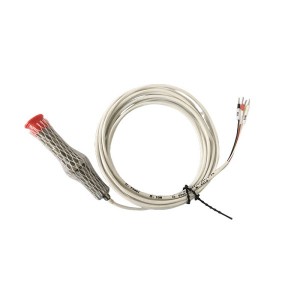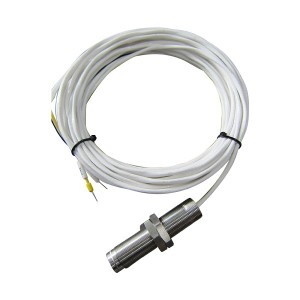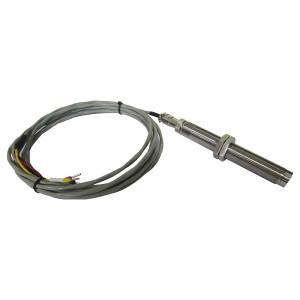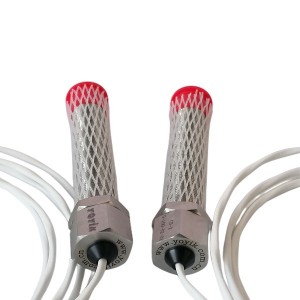In the modern industrial field, especially in the operation monitoring of rotating machinery such as steam turbines, speed sensors play a vital role. Accurate and reliable speed signals are the basis for achieving safe and stable operation of the unit, fault diagnosis and performance evaluation. As a common electromagnetic speed sensor, the performance of the SZCB-01-A1-B1-C3 rotational speed sensor is directly related to the effectiveness of the monitoring system. Below we will focus on the different properties of the gear disc materials, steel and aluminum, which constitute one of the key components of the sensor, and how these properties affect the output signal amplitude of the sensor. Understanding the impact of material selection on sensor performance is an important part of selecting suitable sensors and optimizing monitoring systems for technicians and purchasers in the industrial field.
I. Working principle of SZCB-01-A1-B1-C3 speed sensor
The SZCB-01-A1-B1-C3 speed sensor usually works based on the principle of electromagnetic induction. Its core components include a fixed magnetic element (usually a permanent magnet or an electromagnet) and a gear disc that rotates with the measured shaft. The edge of the gear disc is evenly distributed with tooth grooves. When the toothed disc rotates, the teeth and slots alternately pass through the magnetic field area of the magnetic element, causing periodic changes in the magnetic field strength. According to Faraday’s law of electromagnetic induction, this changing magnetic field will generate an induced electromotive force, that is, a voltage signal, in the induction coil inside the sensor. The frequency of this voltage signal is proportional to the rotation speed and number of teeth of the toothed disc, while the amplitude of the signal is affected by many factors, among which the physical properties of the toothed disc material are one of the key factors.

Specifically, when the teeth are close to the magnetic element, the magnetic flux is easier to pass through due to the high magnetic permeability of the material, and the magnetic field is enhanced; when the slots are close to the magnetic element, the magnetic flux mainly passes through the air, the magnetic resistance increases, and the magnetic field is weakened. This periodic change in the magnetic field induces an AC voltage signal in the coil. The amplitude of the signal directly reflects the severity of the magnetic field change. Therefore, the magnetic and electrical properties of the toothed disc material will directly affect the change of the magnetic field and the magnitude of the induced voltage.
II. Analysis of material properties of steel and aluminum and their impact on signal amplitude
In order to deeply understand the impact of the gear disc material on the output signal amplitude of the SZCB-01-A1-B1-C3 tachometer speed sensor, we need to analyze the physical properties of steel and aluminum respectively, and explore how these properties play a role in the electromagnetic induction process of the sensor.
1. Characteristics of steel and its impact
Steel is a ferromagnetic material with high magnetic permeability. Magnetic permeability is a physical quantity that measures the ability of a material to allow magnetic lines of force to pass through. High magnetic permeability means that steel can be magnetized more easily and can guide magnetic flux more effectively. When a steel gear disc is used, the teeth can significantly enhance the magnetic field strength when passing through the magnetic element, while the grooves cause the magnetic field strength to be relatively weakened. This large magnetic field change amplitude is the basis for generating a higher induced voltage signal.
In addition, the electrical conductivity of steel is relatively low (compared to aluminum). During the electromagnetic induction process, the changing magnetic field not only generates an electromotive force in the induction coil, but also generates eddy currents inside the conductive gear disc material. The generation of eddy currents consumes part of the magnetic field energy, which may weaken the amplitude of the induced signal. However, due to the low electrical conductivity of steel, the eddy currents generated inside it are relatively small, so the energy loss caused by eddy currents is also relatively small. This means that the output signal amplitude of the sensor using a steel toothed disc may be less affected by eddy current losses.

In summary, the high magnetic permeability of steel is its main advantage as a toothed disc material, which can produce strong magnetic field changes and thus obtain higher output signal amplitudes. Although eddy currents will be generated, due to its low electrical conductivity, the eddy current losses are relatively small and the negative impact on the signal amplitude is limited.
2. Characteristics of aluminum and its influence
Aluminum is a non-ferromagnetic material with a magnetic permeability close to that of air, which is much lower than that of steel. This means that aluminum is difficult to magnetize and cannot effectively guide magnetic flux. When an aluminum toothed disc is used, the teeth have a very limited effect on the enhancement of the magnetic field strength when passing through the magnetic element, and the amplitude of the magnetic field change is much smaller than that of a steel toothed disc. According to Faraday’s law of electromagnetic induction, a smaller magnetic field change will result in a smaller electromotive force generated in the induction coil, resulting in a lower output signal amplitude of the sensor.
However, the electrical conductivity of aluminum is very high, much higher than that of steel. This means that in a changing magnetic field, significant eddy currents will be generated inside the aluminum toothed disc. These eddy currents will generate a magnetic field in the opposite direction of the magnetic field change that caused them, effectively shielding or weakening the original magnetic field change. This eddy current effect will cause the amplitude of the magnetic field change around the magnetic element to be further reduced, and ultimately lead to a significant reduction in the output signal amplitude in the induction coil.
Therefore, despite the advantages of aluminum such as light weight and corrosion resistance, its lower magnetic permeability and higher electrical conductivity make it usually result in lower output signal amplitude when used as the toothed disc material of the SZCB-01-A1-B1-C3 pickup speed sensor. Eddy current loss is the main reason for the reduction in signal amplitude.

3. The influence of the interaction of material properties on the output signal
From the above analysis, it can be seen that the magnetic permeability and electrical conductivity of the toothed disc material play a key and often mutually restrictive role in the output signal amplitude of the speed sensor. The high magnetic permeability of steel is conducive to the generation of high-amplitude signals, while its lower electrical conductivity limits the weakening of the signal by eddy current losses. On the contrary, the low magnetic permeability of aluminum directly leads to a lower signal amplitude, while its high electrical conductivity further reduces the signal amplitude by generating strong eddy currents.
In practical applications, the design of the sensor needs to take into account the characteristics of both materials. For example, in order to obtain a higher signal amplitude, steel is usually preferred as the toothed disc material. However, in some occasions where there are strict requirements on weight, or in special environments where corrosion resistance is considered, aluminum may be considered, but it is necessary to accept the compromise of a possible lower signal amplitude, and it may be necessary to compensate for the lack of signal amplitude by optimizing other sensor design parameters (such as the strength of the magnetic element, the number of turns of the coil, etc.).
In summary, due to its high magnetic permeability, the steel toothed disc can produce a strong magnetic field change, thereby obtaining a higher output signal amplitude. Steel toothed discs are generally suitable for application scenarios with high signal amplitude requirements, such as long-distance signal transmission or working in an environment with strong electromagnetic interference. In addition, the mechanical strength and high temperature resistance of steel are generally better than aluminum, making it more suitable for harsh industrial environments with high temperature and high speed such as steam turbines.
Taking into account the complexity of the turbine operating environment and the high requirements for the reliability of the monitoring signal, as well as the excellent magnetic properties, mechanical strength and high temperature resistance of steel, in the SZCB-01-A1-B1-C3 speed sensor, steel is usually a more suitable choice of gear disc material to ensure a sufficiently high output signal amplitude and improve the anti-interference ability and system reliability.

When looking for high-quality, reliable steam turbine rotational speed sensors, YOYIK is undoubtedly a choice worth considering. The company specializes in providing a variety of power equipment including steam turbine accessories, and has won wide acclaim for its high-quality products and services. For more information or inquiries, please contact the customer service below:
E-mail: sales@yoyik.com
Tel: +86-838-2226655
Whatsapp: +86-13618105229
Yoyik offers various types of spare parts for steam turbines, generators, boilers in power plants:
PLC COMMUNICATION MODULE HY-6000VE/03
Shear Pin CJX-09
THEMOCOUPLE RANGE 0-600 C WZP2-630
speed sensor SZCB-01-A3-B1-C3
sensor DSD 1820.19 S22HW
magnetic oil level gauge for transformer UHZ-10C07B
Door Operator MJ01CO-12190004
Limit Switch For 3 Screws On Double Stack MH302-11YW
Pneumatic thruster for ignition gun WHQT-300
Digital Output Module XGO-TR8A
KABEL KONEKTOR DB25
Transmitter 2088G1S22B2B2M4Q4
Battery charger ZE160D20NI
Rectifier for DC system set KZCVA 33
Thermocouple WREKD2-04A
positioner SVX102-XNSDX
Switching power supply module PSMC1-1-220V
Bimetallic thermometer WSS-411
Small machine high profile DF-2000TDZ-A
Expanda Cable Coil IK-530EL
Flame detector EC13R
Proximity Transducer for Differential expansion of turbine ES-25
Load Cell part CS05721OL
motor protector BDM100-M+B
orifice coal flow LNSW-RV-1.0 / 590 x 10
Modul Card SDCS-PIN-4b
Monitor E1668.021
UPS SURT10000UXICH
SEMICONDUCTOR MTC-400-14
Magnetic Speed Pickup Sensor DF6101
Level gauge UHZ-10 C00N
Sensor for measuring H2 purity KQL-1500
Post time: Apr-15-2025













